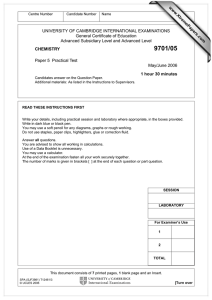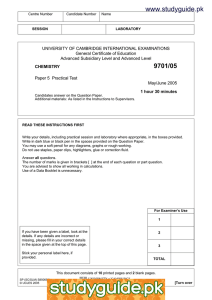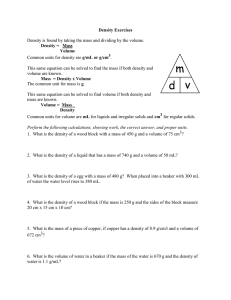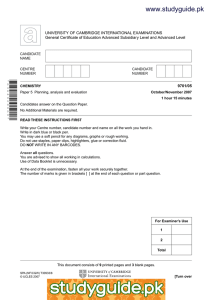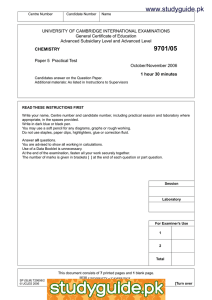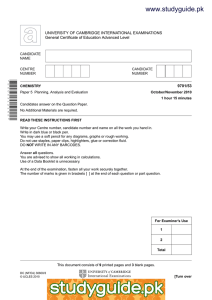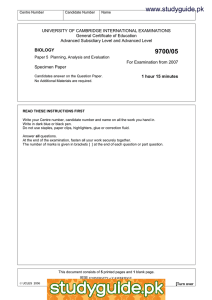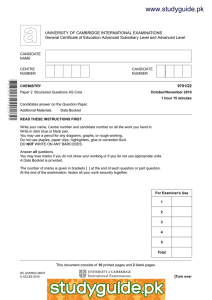www.studyguide.pk
advertisement
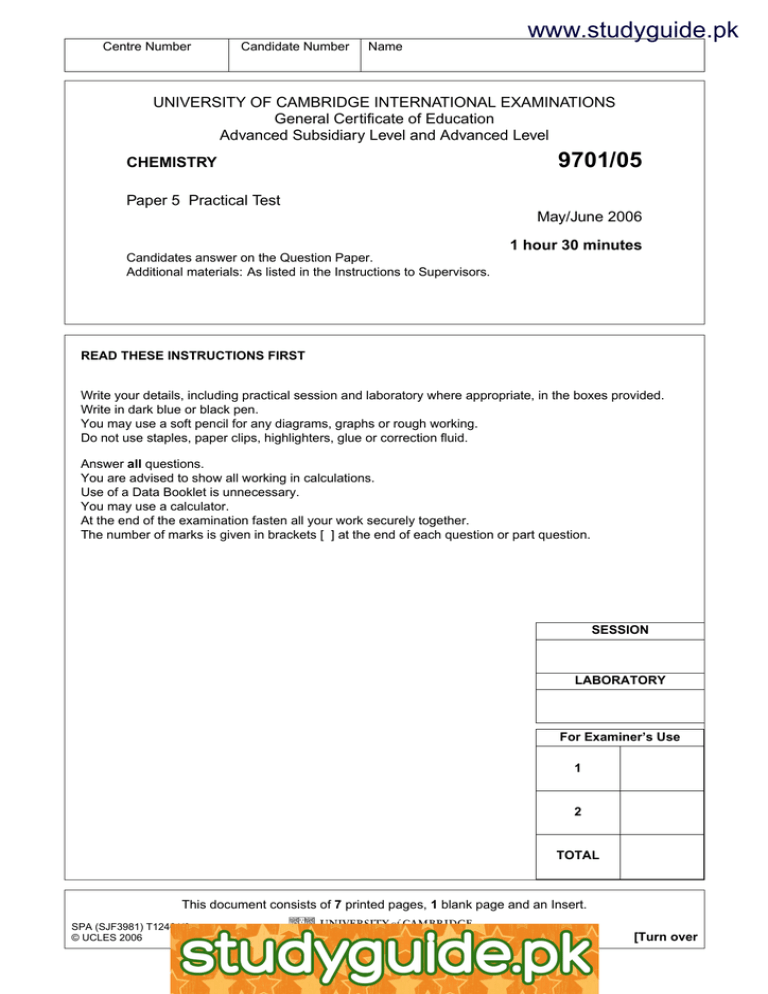
Centre Number Candidate Number www.studyguide.pk Name UNIVERSITY OF CAMBRIDGE INTERNATIONAL EXAMINATIONS General Certificate of Education Advanced Subsidiary Level and Advanced Level 9701/05 CHEMISTRY Paper 5 Practical Test May/June 2006 1 hour 30 minutes Candidates answer on the Question Paper. Additional materials: As listed in the Instructions to Supervisors. READ THESE INSTRUCTIONS FIRST Write your details, including practical session and laboratory where appropriate, in the boxes provided. Write in dark blue or black pen. You may use a soft pencil for any diagrams, graphs or rough working. Do not use staples, paper clips, highlighters, glue or correction fluid. Answer all questions. You are advised to show all working in calculations. Use of a Data Booklet is unnecessary. You may use a calculator. At the end of the examination fasten all your work securely together. The number of marks is given in brackets [ ] at the end of each question or part question. SESSION LABORATORY For Examiner’s Use 1 2 TOTAL This document consists of 7 printed pages, 1 blank page and an Insert. SPA (SJF3981) T12461/3 © UCLES 2006 [Turn over www.xtremepapers.net www.studyguide.pk For Examiner’s Use 2 1 FB 1 is an aqueous solution of sodium thiosulphate, Na2S2O3. FB 2 is dilute hydrochloric acid, HCl. When aqueous sodium thiosulphate is mixed with hydrochloric acid, a fine suspension of solid sulphur is formed. Na2S2O3(aq) + 2HCl(aq) → 2NaCl(aq) + SO2(g) + S(s) + H2O(l) If a beaker containing the reaction mixture is placed over the printed insert provided, the sulphur slowly hides the printing from view. If the depth of solution is constant the printing will always disappear when the same amount of sulphur has been formed. You are to carry out experiments to determine the order of reaction with respect to sodium thiosulphate. (a) Use a 50 cm3 measuring cylinder to transfer 50 cm3 of FB 1 into a 250 cm3 beaker. Dry the outside of the beaker containing FB 1 and place it over the printing on the insert sheet. Measure 5 cm3 of FB 2 using a small measuring cylinder or a test-tube graduated at 5 cm3. Pour the 5 cm3 of FB 2 from the measuring cylinder/test-tube into the beaker and at the same moment start a stop-clock or note the time on a clock with a seconds display. Swirl the beaker to mix the solutions thoroughly and place it back over the insert. Then view the insert from above so that it is observed through the depth of the solution. When the printing on the insert just disappears, record the time to the nearest second in Table 1.1. Empty the beaker and thoroughly rinse with distilled water. Repeat the experiment using the volumes of FB 1, water and FB 2 shown in Table 1.1. Table 1.1 volume of FB 1 volume of water volume of FB 2 time ⎛ 1000⎞ ⎝ time ⎠ / cm3 / cm3 / cm3 /s / s–1 × 103 1 50 0 5 1.70 2 40 10 5 1.60 3 30 20 5 1.48 4 20 30 5 1.30 5 15 35 5 1.18 expt lg(vol FB 1) ⎛ 1000⎞ time ⎠ lg⎝ [6] ⎛ 1000⎞ ⎛ 1000⎞ Calculate ⎝ time ⎠ correct to one decimal place and lg ⎝ time ⎠ correct to two decimal places for each experiment. Record your values in Table 1.1. [lg = log10] © UCLES 2006 9701/05/M/J/06 www.xtremepapers.net [2] www.studyguide.pk 3 (b) Plot lg ⎛ 1000⎞ against lg(volume of FB 1) and draw the best-fit straight line. ⎝ time ⎠ Indicate clearly any point which represents an experimental error and was not considered when drawing the best-fit straight line. For Examiner’s Use [4] © UCLES 2006 9701/05/M/J/06 www.xtremepapers.net [Turn over www.studyguide.pk For Examiner’s Use 4 The rate of reaction with respect to sodium thiosulphate is given by the equation rate = k [Na2S2O3] x where k is the rate constant and x is the order of reaction. The rate equation can be converted into a log form. lg(rate) = x lg[Na2S2O3] + lg k ⎛ 1000⎞ , and [Na S O ] by the volume of FB 1 The rate of reaction can be represented by ⎝ 2 2 3 time ⎠ used. (c) How is the depth of solution kept constant during the experiment? .......................................................................................................................................... .......................................................................................................................................... ..................................................................................................................................... [1] (d) Explain why the volume of FB 1 in each experiment is a measure of [Na2S2O3]. .......................................................................................................................................... .......................................................................................................................................... ..................................................................................................................................... [2] (e) The equation lg(rate) = x lg[Na2S2O3] + lg k is the equation for a straight line and the order of reaction, x, is the gradient of the line. Calculate the value of x from the graph you have drawn on page 3. You must: draw suitable construction lines on the graph, show the numbers obtained from the graph and their use in the calculation. The numerical value of x, the order of the reaction, is ………………………………. © UCLES 2006 9701/05/M/J/06 www.xtremepapers.net [3] www.studyguide.pk For Examiner’s Use 5 ASSESSMENT OF PLANNING SKILLS The rate of reaction between aqueous sodium thiosulphate solution and hydrochloric acid may also be affected by the concentration of the hydrochloric acid. (f) Enter, in Table 1.2, the time and the calculated rate, ⎛ 1000⎞ , from page 2, for experiment 2. ⎝ time ⎠ Data from two further experiments, experiments 6 and 7, together with that from experiment 2, can be used to investigate how the rate of reaction varies as the concentration of hydrochloric acid varies. Enter, in Table 1.2, the volumes of FB 1, water and FB 2 that you would use in experiments 6 and 7 to obtain this data. ⎛ 1000⎞ for each in Table 1.2. Carry out experiments 6 and 7, and record the time and ⎝ time ⎠ Table 1.2 expt 2 volume of FB 1 volume of water volume of FB 2 time ⎛ 1000⎞ ⎝ time ⎠ / cm3 / cm3 / cm3 /s / s–1 × 103 40 10 5 6 7 [3] (g) Use your results to suggest how the rate of reaction depends on the concentration of hydrochloric acid. .................................................................................................................................................. .................................................................................................................................................. ............................................................................................................................................. [1] [Total: 22] © UCLES 2006 9701/05/M/J/06 www.xtremepapers.net [Turn over www.studyguide.pk For Examiner’s Use 6 2 ASSESSMENT OF PLANNING SKILLS Copper has two oxides, CuO and Cu2O. Each oxide can be reduced to copper metal by heating it in a stream of hydrogen gas. The oxide turns to copper metal powder in an exothermic reaction in which the powder may be seen to glow red hot. CuO(s) + H2(g) → Cu(s) + H2O(g) Cu2O(s) + H2(g) → 2Cu(s) + H2O(g) (a) Draw a diagram to show the assembled apparatus you could use in a school laboratory to carry out the reduction of one of the oxides. The apparatus should enable you to: (i) weigh the oxide before heating and the metallic copper after heating, (ii) condense, collect and weigh the steam/water produced, (iii) burn any excess hydrogen after it has passed through the apparatus. You may assume that a supply of hydrogen gas is available – you do not have to prepare the gas. You need not draw a balance. [3] (b) At the start of the experiment the apparatus is full of air. Hydrogen and air mixtures are explosive. What precaution could you take to prevent explosion when igniting the excess hydrogen leaving the apparatus? .......................................................................................................................................... .......................................................................................................................................... ..................................................................................................................................... [1] © UCLES 2006 9701/05/M/J/06 www.xtremepapers.net www.studyguide.pk 7 (c) Why is it necessary to continue passing hydrogen gas through the apparatus until the copper metal formed has cooled? .......................................................................................................................................... .......................................................................................................................................... ..................................................................................................................................... [1] (d) How could you be certain that all of the copper oxide had been reduced to copper? .......................................................................................................................................... .......................................................................................................................................... ..................................................................................................................................... [1] (e) Show how you would use the data you could obtain from the experiment in (a) to deduce the formula of the oxide used. [Ar: Cu, 63.5; O, 16.0] [2] [Total: 8] © UCLES 2006 9701/05/M/J/06 www.xtremepapers.net For Examiner’s Use www.studyguide.pk 8 BLANK PAGE Permission to reproduce items where third-party owned material protected by copyright is included has been sought and cleared where possible. Every reasonable effort has been made by the publisher (UCLES) to trace copyright holders, but if any items requiring clearance have unwittingly been included, the publisher will be pleased to make amends at the earliest possible opportunity. University of Cambridge International Examinations is part of the University of Cambridge Local Examinations Syndicate (UCLES), which is itself a department of the University of Cambridge. 9701/05/M/J/06 www.xtremepapers.net
